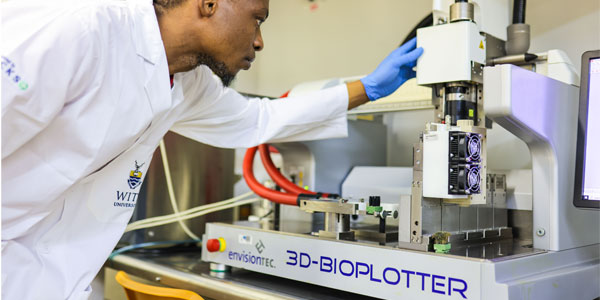Printing 3D patches to heal wounds
- Marcia Zali
New biotechnical treatments can fast-track recovery from traumatic injuries.
Researchers at the Wits Advanced Drug Delivery Platform (WADDP) in the Department of Pharmacy and Pharmacology at Wits are on a mission to revolutionise the way we treat wounds. By using new technologies that target specific wounds, these treatments will eventually help the body heal itself.
WADDP researcher and Lecturer in Pharmacy and Pharmacology, Dr Poornima Ramburrun and her colleagues are looking into ways of combining the use of conventional treatment methods, such as anti-inflammatories and painkillers with biotechnological innovations like implants and 3D printable material to heal wounds.
“Tissue regeneration and wound healing is such a complex process; we have to combine all these systems to improve tissue regeneration. We can’t only focus on one element because all of these mechanisms come into play,” says Ramburrun. “Conventional drugs like anti-inflammatories, paracetamol and antibiotics remain critical in the healing process and are not likely to be replaced anytime soon.”

Combined treatments
As an example of how a combination of drugs and bioactive compounds can work together to become an effective tissue regeneration treatment, Rambarrun referred to one of her studies, which focuses on tissue regeneration of the peripheral nerve. In this study, she uses a bioactive growth factor that helps little nerves to sprout, combined with diclofenac sodium – a typical anti-inflammatory and pain medication –?and an antioxidant to protect the newly regenerated tissues from any further injury or inflammation.
“We are trying to reduce the dosage of medication that patients need to take by sending the drugs directly to the site where they are needed,” says Ramburrun. “We know that the drugs are reaching the tissues that really need it and we are also using a much smaller quantity through the implant, because it will be implanted at the required site.”
PhD student at the WADDP, Kate Da Silva, focuses on healing internal trauma to the liver caused by stabbings, gunshots, or car accidents. Instead of using the general approach of treating the entire organ, Da Silva focuses on the exact location of the wound in the liver.
3D printing
“We use an injectable, 3D printed biodegradable material that will be absorbed by the body once healing is complete,” says Da Silva, adding that the aim is to only treat patients who suffered recent, acute trauma to the liver.
“By using this treatment plan, we can cause the tissues to regenerate back to their original state while reducing the amount of medication patients need to take during recovery. We are using the body’s own regenerative hormones as a drug to cause native regeneration in the liver.”
Sameera Khatib, a Master’s student in Pharmacy at the WAADP, like Ramburrun, also focuses on the peripheral nerve –?aiming to create an artificial ‘bridge’ of the nerve when injury occurs. This conduit helps the nerves to heal themselves. “My research tries to expedite that regenerative step by making a conduit at the place of injury, which will trick your body into thinking that there is structural support and will begin the regenerative process,” says Khatib.
The goal for both Rumburrun and Da Silva is that they are able to commercialise their research so that patients can benefit from treatment that ultimately improves the healing process, reduces side-effects, and further aids adherence to treatment.
- Marcia Zali is a freelance writer.
- This article first appeared in?Curiosity,?a research magazine produced by?Wits Communications?and the?Research Office.
- Read more in the 16th issue, themed: #Drugs, where we highlight the diversity, scope, and multi-dimensional nature of drug-related research at Wits University.

